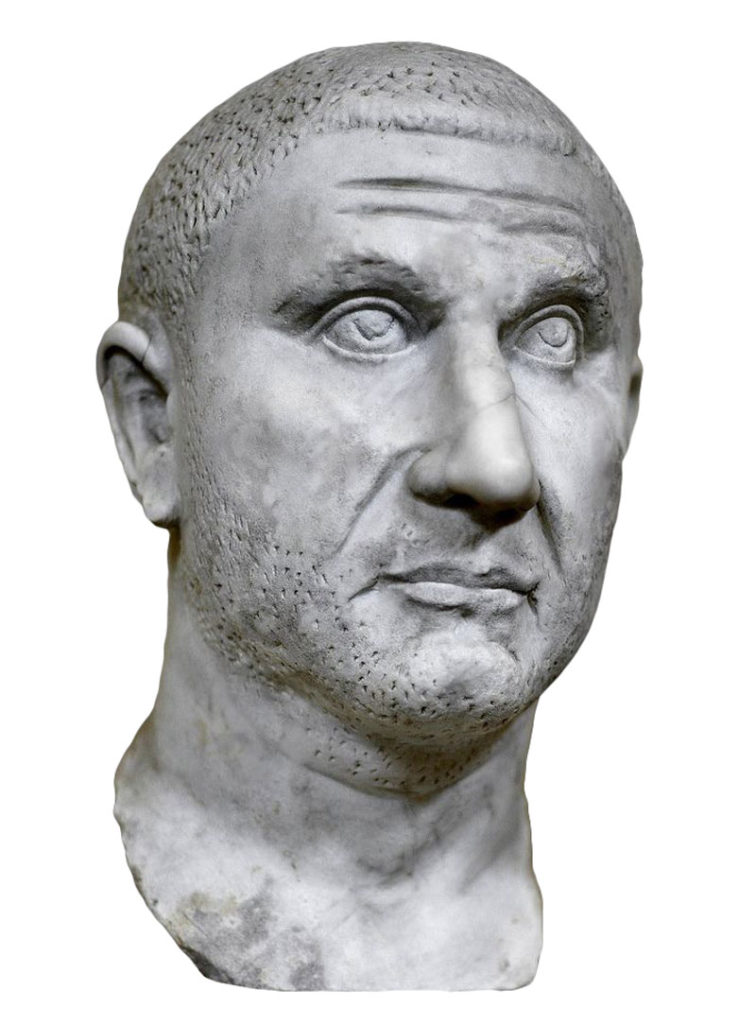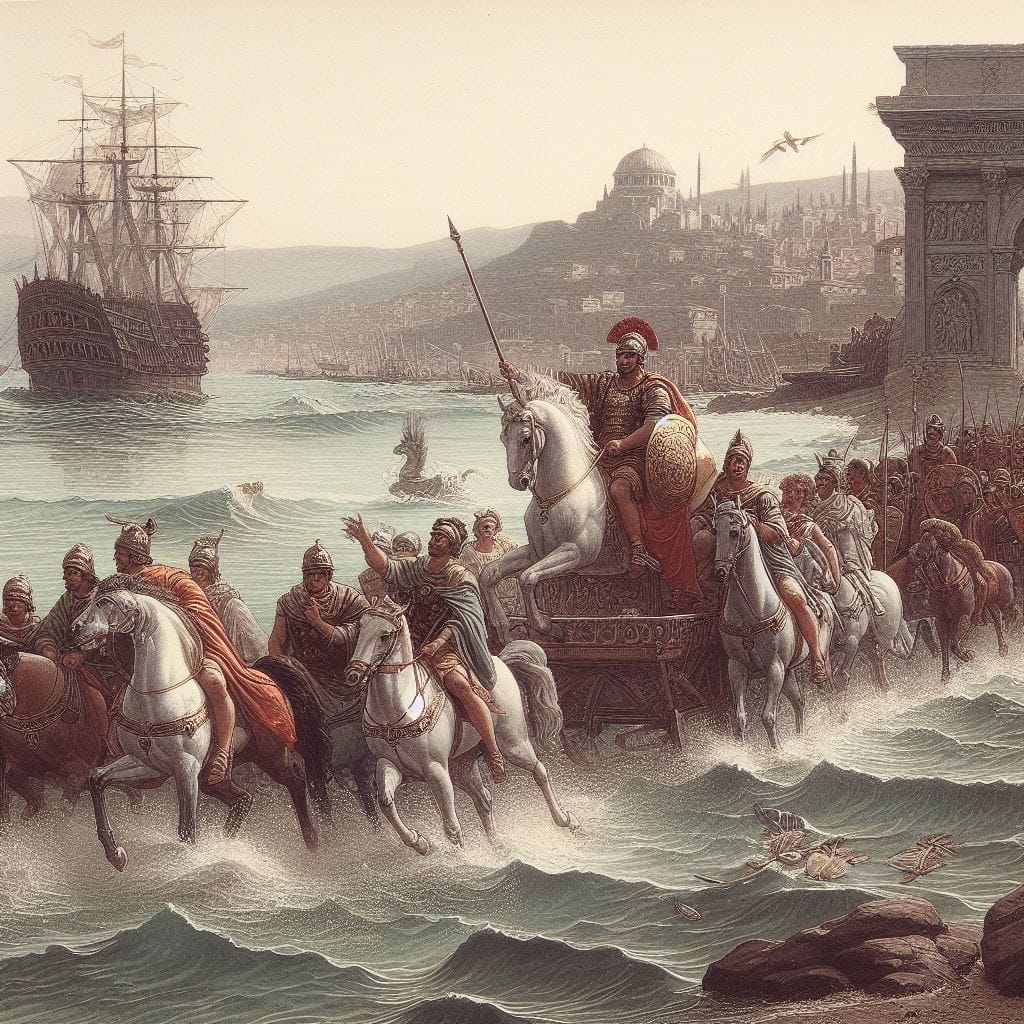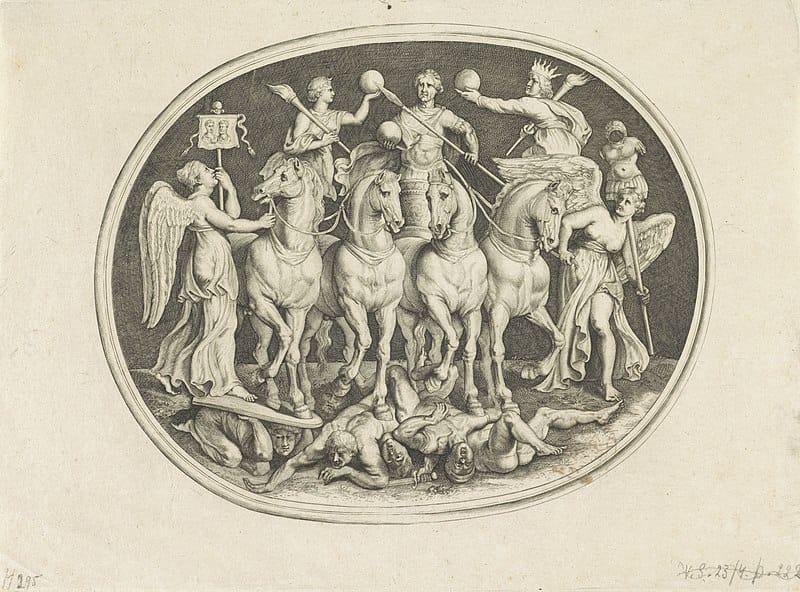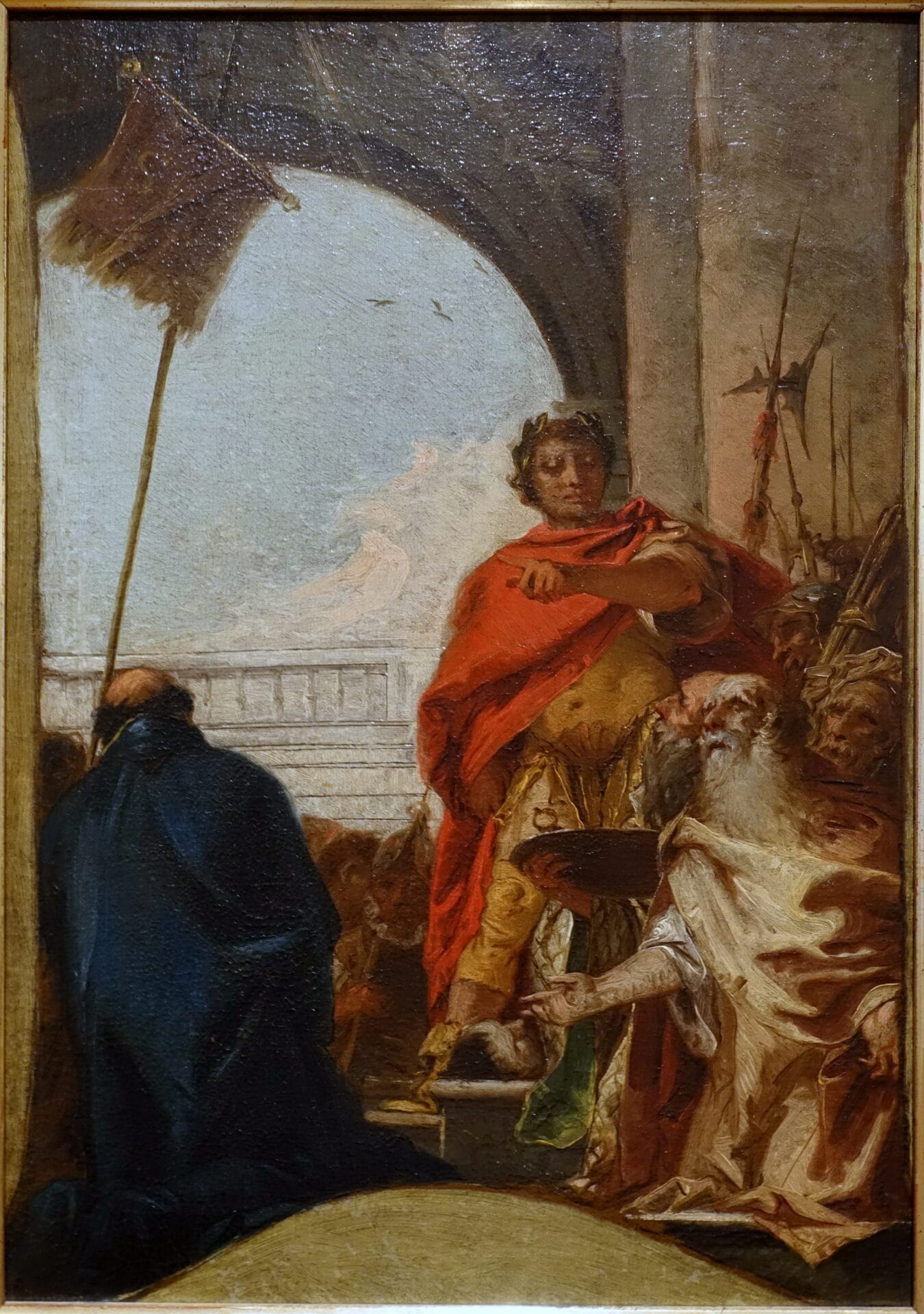Life: AD c. 250 – 324

- Name: Valerius Licinius Licinianus
- Born in AD ca. 250 in Upper Moesia.
- Became emperor on 11 November AD 308.
- Wife: Constantia (one son; Licinius).
- Died at Thessalonica early in AD 325.
Licinius’s Early Life
Licinius was born in Upper Moesia in about AD 250 as the son of a peasant. He rose through the ranks of the military and became the friend of Galerius. It was during Galerius’ campaign against the Persians in AD 297 that his performance is said to have been especially impressive. He was rewarded with a military command on the Danube.
It was Licinius who travelled to Rome on Galerius‘ behalf to negotiate with the usurper Maxentius in Rome. His mission proved unsuccessful and resulted in Galerius’ consequent attempt to invade Italy in AD 307.
Becoming an Augustus
At the conference of Carnuntum in AD 308, Licinius was, on the behest of his old friend Galerius, suddenly raised to the rank of Augustus, adopted by Diocletian, and was granted the territories of Pannonia, Italy, Africa, and Spain (the latter three only in theory, as Maxentius still occupied them).
Licinius’s promotion to Augustus, without having previously held the rank of Caesar, ran contrary to the ideals of the tetrarchy and quite literally ignored the greater claims of Maximinus II Daia and Constantine. All that appeared to have earned him the throne was his friendship with Galerius.
Licinius, with only the territory of Pannonia, was clearly the weakest emperor despite his title of Augustus, and so he had good reason to worry. In particular, he saw Maximinus II Daia as a threat, and so he allied himself with Constantine by becoming engaged to Constantine’s sister Constantia.
The Balkan Campaign
Then, in AD 311, Galerius died. Licinius seized the Balkan territories, which had still been under the deceased emperor’s control but could not move fast enough to establish his rule over the territories in Asia Minor (Turkey), which were instead taken by Maximinus II Daia.
An agreement was reached by which the Bosporus was to be the border between their realms. But Constantine’s victory at the Milvian Bridge in AD 312 changed everything. Had the two sides been preparing against each other anyway, then now it was essential for either one to defeat the other in order to equal the power of Constantine.
It was to be Maximinus II Daia who made the first move. While Licinius was continuing his shrewd policy of alliance with Constantine by marrying his sister Constantia at Mediolanum (Milan) in January AD 313 and confirming Constantine’s famous Edict of Milan (toleration of Christians and Constantine’s status as senior Augustus), Maximinus II’s forces were gathering in the east, preparing to launch an attack.
Still, in the winter of early AD 313, Maximinus II set across the Bosporus with his troops and landed in Thrace. But his campaign was doomed for failure. Had Maximinus II Daia driven his troops across wintery, snow-bound Asia Minor (Turkey), they would have been utterly exhausted. Despite their highly superior numbers, they were defeated by Licinius at Campus Serenus, near Hadrianopolis, on either 30 April or 1 May AD 313.

What is further worth noting is that, on this occasion, Licinius’ forces fought under a Christian banner, just as Constantine’s had done at the Milvian Bridge. This was due to his acceptance of Constantine as the senior Augustus and his subsequent acceptance of Constantine’s championship of Christianity. It stood in stark contrast to the strongly pagan views of Maximinus II.
The Rule of Two Men
Maximinus II Daia retreated back to Asia Minor and withdrew behind the Taurus mountains to Tarsus. Having set across to Asia Minor, Licinius in Nicomedia issued his own edict in June AD 313, by which he officially confirmed the Edict of Milan and formally granted complete freedom of worship to all Christians.
Meanwhile, he was not held back for long by the fortifications on the passes across the mountains. He pushed through and laid siege to his foe at Tarsus. Finally, Maximinus II either succumbed to serious illness or took poison (August AD 313). With Maximinus II Daia dead, his territories naturally fell to Licinius.
This left the empire in the hands of two men, Licinius in the east and Constantine (who had since defeated Maxentius) in the west. Everything east of Pannonia was in the hands of Licinius, and everything west of Italy was in the hands of Constantine.
Attempts were made to bring the war-torn empire to peace. Had Licinius accepted Constantine as the senior Augustus, then he thought he still possessed complete authority over his own eastern territories. To all intents, the two emperors could, therefore, peacefully co-exist without one challenging the authority of the other.
The problem between Constantine and Licinius arose when Constantine appointed his brother-in-law Bassianus to the rank of Caesar, with authority over Italy and the Danubian provinces. The other side saw in Bassianus only a puppet of Constantine’s and hence vehemently disliked this appointment. Why should he forfeit control over the important military provinces in the Balkans to a man of Constantine’s?
Going to War
And so he developed a plot by which he incited Bassianus to revolt against Constantine in AD 314. But his involvement in this affair was detected by Constantine, which consequently led to a war between the two emperors in AD 316.
Constantine attacked and defeated a numerically superior force at Cibalae in Pannonia, and Licinius retreated to Hadrianopolis. Defiantly, he now elevated Aurelius Valerius Valens to the rank of Augustus of the west in an attempt to undermine Constantine’s authority.

After a second, though inconclusive battle at Campus Ardiensis, the two emperors divided the empire afresh, Licinius losing control of the Balkans (except for Thrace) to Constantine, which were in effect under Constantine’s control since the battle of Cibalae. Constantine’s rival emperor, Valens, was left absolutely stranded and was simply executed.
The Unsuccessful Treaty
Licinius, by this treaty, though, still retained full sovereignty in his remaining part of the empire. This treaty, one hoped, would settle matters for good. To further complete the semblance of peace and restore unity, three new Caesars were announced in AD 317. Constantine and Crispus, both sons of Constantine, and Licinius, who was the infant son of the eastern emperor.
The empire remained at peace, but relations between the two courts soon began to break down again. The main cause for the friction was Constantine’s policy toward the Christians. Did he introduce several measures in their favor, and then Licinius increasingly began to disagree? By AD 320 and 321, he had returned to the old policy of suppressing the Christian church in his eastern part of the empire, even expelling Christians from any government positions.
Further cause for trouble was the granting of annual consulships. These were traditionally understood by emperors to be positions in which to groom their sons as heirs to the throne. Was it understood at first that the two emperors would appoint consuls by mutual agreement, Licinius soon felt that Constantine was favoring his own sons. He therefore appointed himself and his two sons as consuls for his eastern territories for the year AD 322 without consulting Constantine. This was an open declaration of hostility, though it did not in itself immediately lead to a response.
The Second War
But in AD 322, to repel Gothic invaders, Constantine crossed into Licinius’ territory. This gave Licinius all the reason he needed to cry foul, and by the spring of AD 324, the two sides were at war again. He began the conflict confidently at Hadrianopolis, with 150,000 infantry and 15,000 cavalry at his disposal, as well as a fleet of 350 ships. Constantine advanced on him with 120’000 infantry and 10’000 cavalry. On the 3rd of July, the two sides met, and Licinius suffered a severe defeat on land and fell back to Byzantium. Shortly after, his fleet, too, suffered a bad mauling by Constantine’s fleet, commanded by his son Crispus.
His cause in Europe lost, and Licinius retreated across the Bosporus, where he elevated his chief minister Martius Martinianus to be his co-Augustus in much the same way as he had promoted Valens a few years earlier. But soon after Constantine landed his troops across the Bosporus and on 18 September AD 324 at the battle of Chrysopolis, he was defeated yet again, fleeing to Nicomedia with his 30,000 remaining troops.
The Fall of Licinius
But the cause was lost, and Licinius and his small army were captured. His wife Constantia, who was the sister of Constantine, pleaded with the victor to spare both her husband and the puppet emperor Martianus. Constantine relented and instead imprisoned the two. But soon after, accusations arose that Licinius was plotting a return to power as an ally of the Goths. And so he was hanged (early AD 325). Martianus, too, was hanged not much later, in AD 325.

Licinius’ defeat was a complete one. Not only did he lose his life, but so too did his son and supposed successor, Licinius the Younger, who was executed in AD 327 at Pola. And his illegitimate second son was reduced to the status of a slave laboring at a weaving mill in Carthage.
People Also Ask:
Did Licinius convert to Christianity?
At the time, Christian writers regarded Licinius as a Christian; though he prescribed a monotheistic prayer for use by the army, his later career shows that he was no convert.
Who defeated Licinius?
In 324, Constantine defeated him at Adrianople and again at Chrysopolis (now Üsküdar, Tur.). Licinius surrendered, was exiled to Thessalonica, and was executed the next year on a charge of attempted rebellion.
Who was emperor Licinius?
Valerius Licinianus Licinius (c. 265 – 325) was Roman emperor from 308 to 324. For most of his reign, he was the colleague and rival of Constantine I, with whom he co-authored the Edict of Milan, AD 313, which granted official toleration to Christians in the Roman Empire.
Why did Constantine and Licinius go to war?
In 320, Licinius reneged on the religious freedom promised by the Edict of Milan in 313 and began to oppress Christians anew. It became a challenge to Constantine in the west, climaxing in the great civil war of 324. Licinius, aided by Goth mercenaries, represented the past and the ancient Pagan faiths.

Historian Franco Cavazzi dedicated hundreds of hours of his life to creating this website, roman-empire.net as a trove of educational material on this fascinating period of history. His work has been cited in a number of textbooks on the Roman Empire and mentioned on numerous publications such as the New York Times, PBS, The Guardian, and many more.
